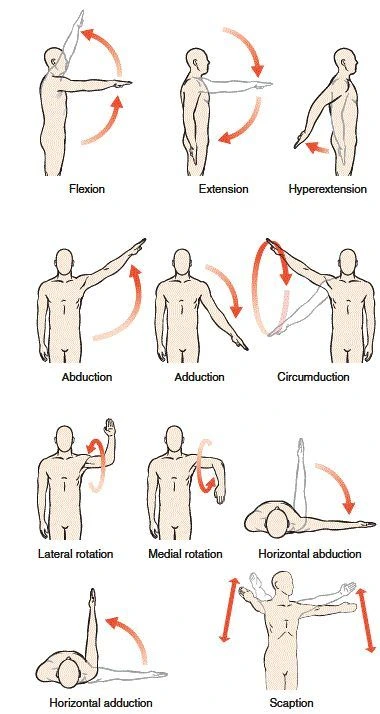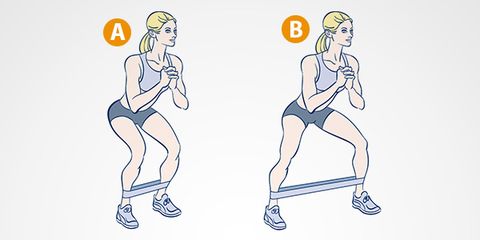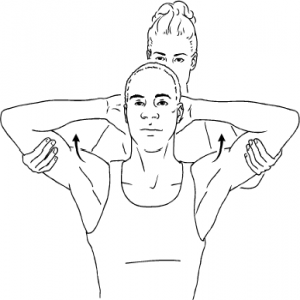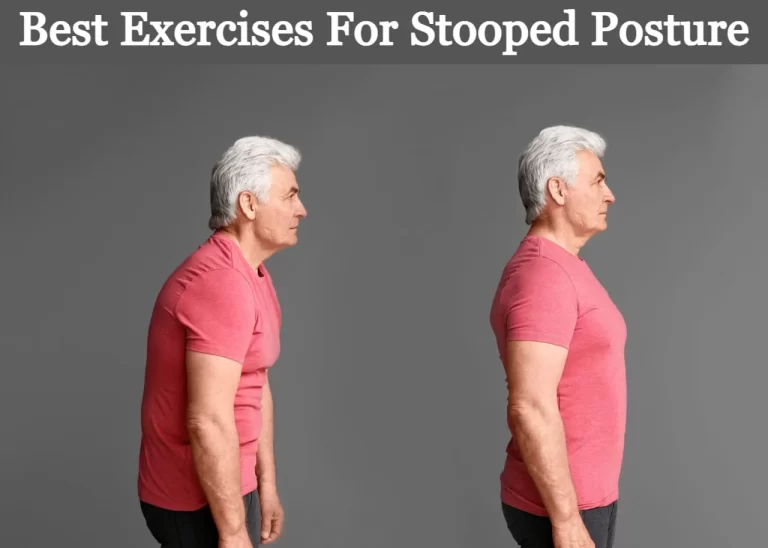Best exercises for Shoulder joint
Introduction:
If you are searching for the Best Exercise for your Shoulder joints, we discuss various exercises that really improve your shoulder functioning.
The shoulder joint is one of the two most versatile joints in the human body, with the greatest range of movement, But that equal mobility also makes them vulnerable to injury. That is why it is more important to actively strengthen the shoulder muscle by regularly doing shoulder exercises. The shoulder joint is also known as a glenohumeral joint. This is structurally made up of ball and socket types. This articulates with the humeral head with the glenoid cavity of the scapula bone.
Many researchers recommend doing targeted shoulder workouts two times a week and spreading them out so your muscles have enough time to rest.
You also can do exercise of your shoulder muscle more than twice a week, but keep in brain that they will also be engaged during many chests, back, and arm exercises, and even HIIT or Pilates.
If you want to specifically strengthen shoulder muscle, then you need to perform movements that use multiple angles to hit each part of the deltoid muscle.
The great shoulder workouts will include a variety of moves to work your rotator cuff muscles and all head of deltoid muscles so you can build strength, stability, and mass.
To help you get started, we have pulled together some of the best movements all you need is a pair of weights in form of dumbbells or kettlebells, or a resistance band.
The shoulder muscles work in two motions. The 1st motion is a push, which includes exercises such as push-ups, handstands, and bench or overhead presses. The 2nd is when you raise something away from your body, which includes lifting in front, to the side of you, or even swinging your arms posteriorly. The movement direction determines which of the shoulder muscles are predominantly utilized.
A strong set of shoulders is important for an activity of daily living. Not only does the shoulder joint have the largest range of motion in the body, but the muscles around the shoulder girdle are also responsible for moving your arms wherever you need them to go. look around every people caring about your health and have a daily exercise, this will emphasize a healthy lifestyle, no matter which type of exercise you can do.
The shoulder joint is a very sensitive part of our body. Bearing a lot of strain and stress almost all day, the shoulder muscles if not always active may turn to suffer over the years. Gracefully a well-defined set of shoulders looks phenomenal on both males and females. Furthermore, shoulder exercise enhances the strength of the muscles situated around the shoulder joint, such as the arms, and thus provides more strength and stability to the body. A network of motion of the human body is interconnected to the shoulder. Thus, weak shoulder muscles do not permit flexible movement of these parts and thus may cause stiffness and injury. The rotator muscle stabilizes the shoulder joint so, it must be trained to avoid injury.
The shoulder joint is the most flexible in the human body so it is the most unstable part of the body. A huge number of game activities need the movement of the shoulders such as golf. Many everyday activities, such as lifting heavy objects like handling little children, groceries, and household chores may strain your shoulders. To be able to handle this outside pressure, your shoulder muscle must be strengthened. All we know is that conveniently adopted the fast-paced life caught not aware of the consequences of such a lifestyle. We mostly forget to exercise and have not learned to prioritize our life in such a way that the body must benefit. Workout is food for the soul. It will nourish the organs and revitalizes the cells. It is refreshing and enhances a healthy lifestyle.
Which muscles are covered the shoulder joint?
so we may begin to build up the muscles in our shoulders without knowing what muscles are around our shoulder joints. The shoulder is made up of 2 groups of muscles: extrinsic muscles, which arise from the trunk and attach to the bones of the shoulder, and intrinsic muscles, which arise from the scapula and/or clavicle and are inserted into the humerus.
The Shoulder’s Extrinsic Muscles
- Trapezius
- Latissimus Dorsi
- Levator Scapulae
- Rhomboids
The Shoulder’s Intrinsic Muscles
- Deltoids
- Teres Major
- Rotator Cuff:
- Subscapularis.
- Infraspinatus.
- Teres minor.
- Supraspinatus
Benefits of shoulder exercises:
- Helps to improve your muscle strength, muscle tone, and lean muscle mass.
- Helps to improve your posture or maintain good posture.
- Helps to decrease the risk of a shoulder injury.
- Helps to protect your bones.
- Helps to stabilize your joints.
- Helps to fulfill Many day-to-day activities, such as lifting heavy objects like groceries, handling little children, and household chores.
- Helps to give other workouts a boost.
- This will improve your metabolism.
- It is incredibly rewarding.
- Helps to do easier daily tasks.
There has a lot of exercises to strengthen your shoulder joint:
Side lateral raise
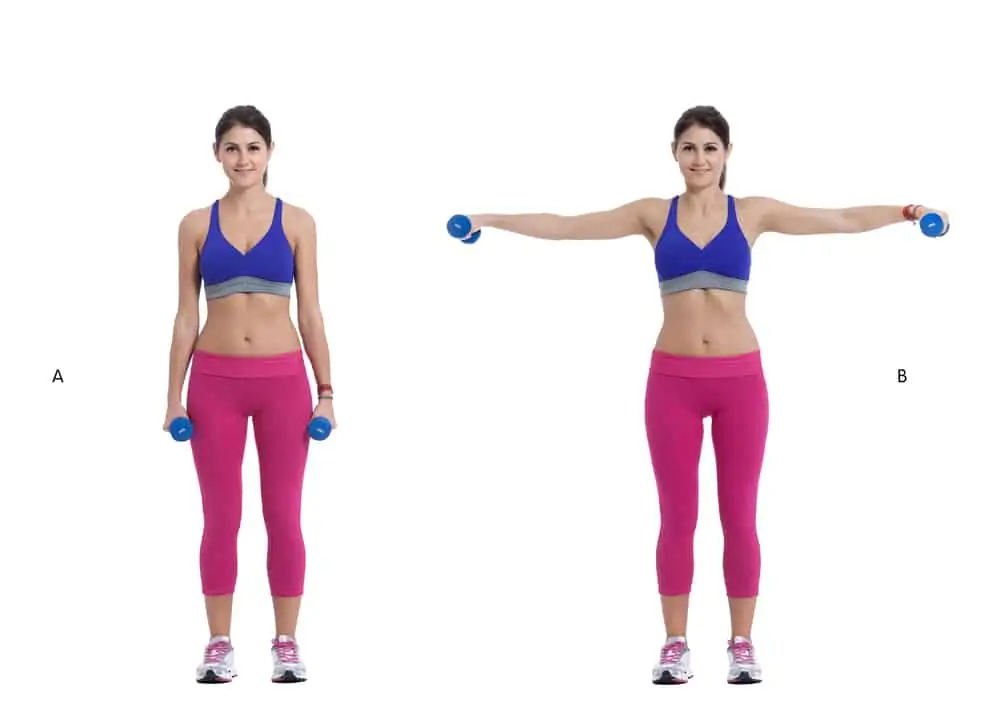
- To do this exercise you have to Stand tall with the dumbbell in both hands.
- Arms by your sides, palms facing in.Move your shoulders back, contract your core, and look straight ahead.
- Elevate your arms simultaneously just a couple of inches out to each side and hold for 5 seconds. This small pause should help to ensure you disengage your trapezius muscle from the movement, you have to target only the deltoids.
- Your body should form a “T” shape. Inhale when you lift the dumbbell.
- Lower the dumbbells slowly, bringing your arms back to your sides.
- Exhale as you lower the dumbbells. Do this for 10 to 20 repetitions for 2 to 3 sets.
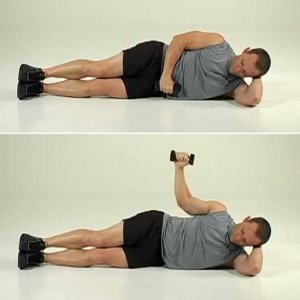
External rotation
- To do this exercise you have to Lie on your side Hold your head with your hand Slightly flex your hips and knees hold the dumbbell in your hand.
- Put your elbow on your side, around the crease of your hips, with your hand and the weight touching your tummy.
- Now move your forearm upward and away from the body with the arm in a static position.
- Do this for 10 to 20 repetitions for 2 to 3 sets.
Overhead press

- To do this exercise you have to Stand upright and your back should be straight. grab a dumbbell in both hands, at the shoulders, with an overhand grip.
- Thumbs kept inside and knuckles facing up.Breathe out as you raise the dumbbell above the head in a controlled motion.
- Hold for 5 seconds at the top of the motion.
- Breathe in and back the dumbbells to the shoulder joint. Do this for 10 to 20 repetitions for 2 to 3 sets
Arnold press
- To perform this exercise you have to Sit on a bench with dumbbells hold in front of you, palms facing your shoulders as though you have just finished a bicep curl.
- Push the weight up over your head by rotating your arms until your palms go away from you. extend your arms, pause, then reverse the movement.
- Do this for 10 to 20 repetitions for 2 to 3 sets.
Front raise
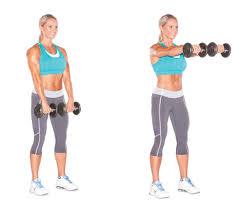
- To perform this exercise you have to Stand with your shoulder-feet width apart.
- Allow your arms to hang in front of you with the weight in front of the thighs (palms facing the thighs). Your back should be straight, your feet should be flat on the floor, and your abdominal muscles are engaged.
- raise the dumbbells upward while breathing in. Your arms are extended, palms facing down, with slightly flexed elbows to decrease the stress on the joints.
- Hold for a second briefly when your arms are horizontal to the ground.
- Lower the weight to the initial position (at the thighs) with a slow and controlled motion while breathing out. Do this for 10 to 20 repetitions for 2 to 3 sets.
Reverse fly
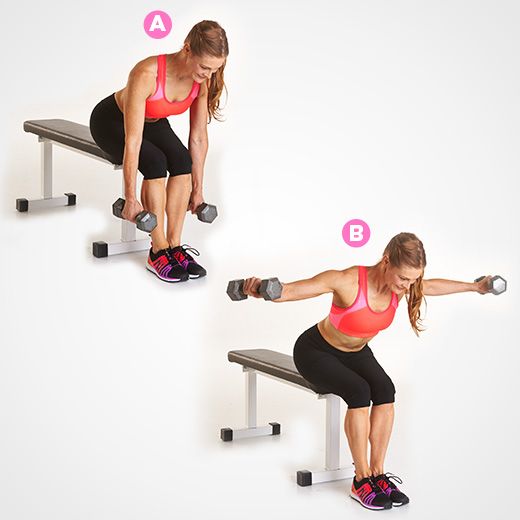
- To do this exercise you have to Stand with feet shoulder-width apart and grab dumbbells by your sides. push the hips back in a hinge motion, and move your chest forward and almost parallel to the ground.
- Let the dumbbells hang straight down (palms facing each other) while maintaining a tight core, straight back, and slight knee flexed. elevate both arms out to your side with the breath out.
- The elbow is slightly flexed. Contract the shoulder blades simultaneously as you pull them toward the spine.
- Lower the weight back to the start position as you breathe in. take care of your shoulder joint from hurching, and tuck your chin to maintain a neutral spine during the reverse fly.
Dumbbell shoulder press
- To perform the dumbbell shoulder press exercise you have to Stand straight and keep your back straight. Hold a dumbbell in each hand, at the shoulders, with an overhand grip. Thumbs should be inside and knuckles face up.
- Exhale as you raise the weights above the head in a controlled motion.
- Hold for five seconds at the top of the movement.
- Breathe in and return the weight to the shoulders.
Cable lateral raise
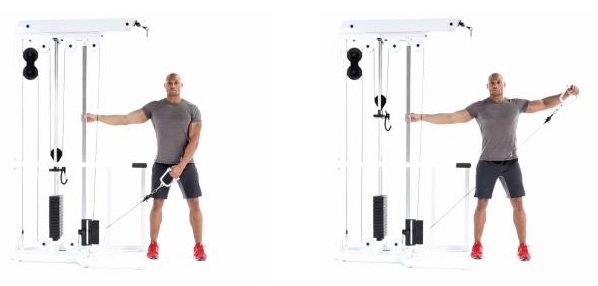
unilateral or one-arm cable lateral raise:
- To perform this exercise you have to Attach a handle to the lower pulley setting.
- To utilize your left shoulder muscle, stand with your right side to the cable machine. The side you pretend to work on should be facing away from the pulley. your feet should be hip-width apart and keep your back straight.
- Stand tall by pulling your shoulders backward and pushing your chest forward. flexed your knees slightly. You can choose to either grab the tower of the cable machine with your right hand for support, put your right arm on your hip, or leave it hanging at your side.
- This is entirely up to you, Move your left hand across your body and hold the handle.
- Flexed your elbow slightly without moving your palms away from the face-down position.
- Breathe out, Focus the movements on your shoulders, pull the cable, and lift your arms outward until it is at shoulder level and parallel to the floor.
- Pause at the peak of your movement to maximize contraction.
- Breathe in and slowly lower your arms to the initial position across your body while retaining tension in your shoulders.
- This is 1 repetition. Complete 10 to 20 repetitions in 2 to 3 sets.
- Complete three sets before switching to your left arm.
The bilateral or two-arm cable lateral raise uses the two hands simultaneously.
Bilateral or two-arm cable lateral raise:
- You have to Stand between the two cable stations. Fix the handles in both cables to the lowest pulley setting.
- Pick both handles with your arms crossed in front of you so that your left arm pulls the cable on your right and your right arm pulls the cable on your left. Stand straight with your back straight and chest stretched. Keep your feet hip-width apart.
- Flex your elbows at a 10-degree angle. from the shoulders, pull both cables outward, so they cross each other in front of you.
- Slowly twist your hand, so your little finger is slightly upward. At the lateral raise position, your arms should be at shoulder height.
- Hold this position for 15 seconds. Slowly lower your arms until they cross in front of you like in the initial position.
- Complete 10 to 20 repetitions in 2 to 3 sets.
Rear delt fly
- To perform a Rear delt fly you have to Set an incline bench to a relatively low angle, lower than you should for exercises like incline dumbbell presses. Now, Sit on the bench with holding a pair of dumbbells and lean forward so that your chest rests on the back pad, facing toward the floor.
- put your feet on the floor and contract your glutes and abdominal muscles, your face should not be resting on the bench pad. never let your trunk lose contact with it with the bench.
- Contract your shoulder blades to lift the dumbbell out in a wide arch, the elbow should be slightly flexed rather than fully extended. your movement-wide to maintain the focus on your rear delts, instead of slipping down into your lattissumus dorsi. Hold for a beat at the top, emphasizing the squeeze to your shoulder blades.
- Then, return to the starting position with control. Do this for 15 to 20 repetitions for 2 to 3 sets.
Face pull
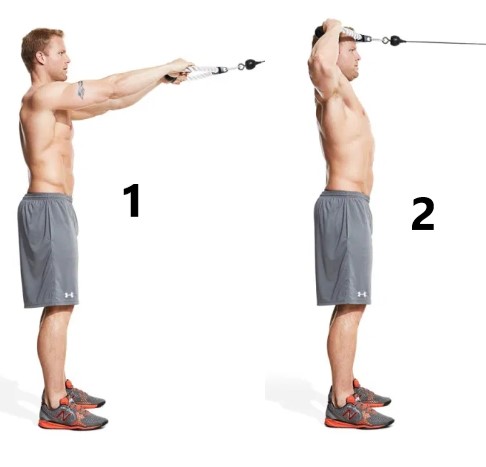
- To do a face pull you Set up a cable pulley machine so the pulley system is placed slightly above your head. Use the rope attachment that features each hand-holds for this exercise.
- Reach upward and hold the handles with each hand with your palms facing in.
- Take a backward step until your arms are fully extended, then contract your core and lean backward slightly, placing your body at a roughly thirty-degree angle. pull the rope toward the body just enough to start lifting the weight from the rack, then contract your shoulders, rolling them back to create the correct posture you don’t want your shoulders rolling forward. This is your beginning position.
- Pull the handles of the attachment toward your forehead in a straight line. your palms should be facing in as your elbows flare outward toward the sides, engaging the rear deltoids. Reverse the movement and slowly straighten your arms without allowing your shoulders or chest to roll forward as you extend.
- You have to maintain correct posture throughout the exercise.
- Start by doing two sets of 20 repetitions. start with some lighter weight than you think you need to and focus on slow, controlled motions to get perfect results.
Seated dumbbell press
- To do the seated dumbbell press you have to Sit on a chair or adjust the bench to 90 degrees angle and hold two dumbbells of the same weight. Pick up the dumbbell from the floor using a neutral grip (palms facing inwards) and rest the dumbbell on your thigh. Use your lower body to help you lift each dumbbell simultaneously to shoulder height.
- When dumbbells reach shoulder height, then rotate your palms so that they are facing forward, and keep your elbows flexed close to 90 degrees.
- Start pressing the dumbbells by elevating the weight above your head until your elbows are fully extended. Hold the position for 5 seconds before returning the dumbbells to shoulder height. That is one repetition.
Bent-over lateral raise
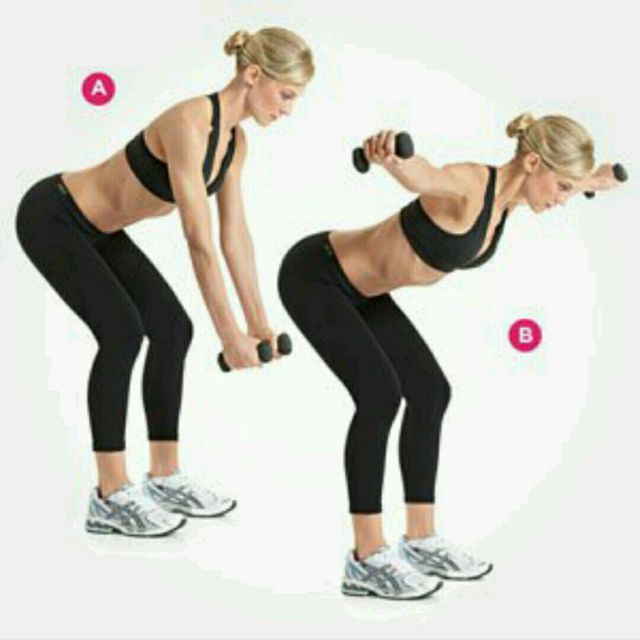
- For bent-over lateral raises, start by using a weight that you can continue for 2–3 sets of 10–15 repetitions. Choose a weight that allows you to maintain perfect technique throughout all sets and repetitions.
- Begin by grabbing a pair of dumbbells, and stand with your feet shoulder-width apart and a slight do dome flexion in the knees. The shoulder joints should be directly over the hip joint with a normal head and neck position.
- Your chin should be tucked in throughout the movement as if you were holding an egg in your chin. Evenly distribute your weight to the foot to get a stable position.
- With maintaining a neutral spine, hinge your hips back. Your tibial shins should be vertical and your upper limb should be at a 40-degree angle. You can feel your lower limb working to support your position.
- Your arms should be extended mostly with slight flexion in your elbows and your palms facing each other. your shoulders rotate outward to engage your lattisimus dorsi. Your shoulder blades should be in a neutral position. Every new repetition should be initiated from this position.
- From this position, you have to contract your posterior deltoids to initiate the upward movement. Raise your arms until your upper arm is even with your back. When you raise the weight, your shoulder blades should retract. Your palms should be lower than your upper arms. Hold for the10 seconds at the top of the movement.
- Gently lower your arms until the weight is back in the initial position. As you lower the weight, your shoulder blades should be protracted. Lower the weight only as much as you can maintain tension on your rear deltoids.
- Repeat 10 to 12 times.
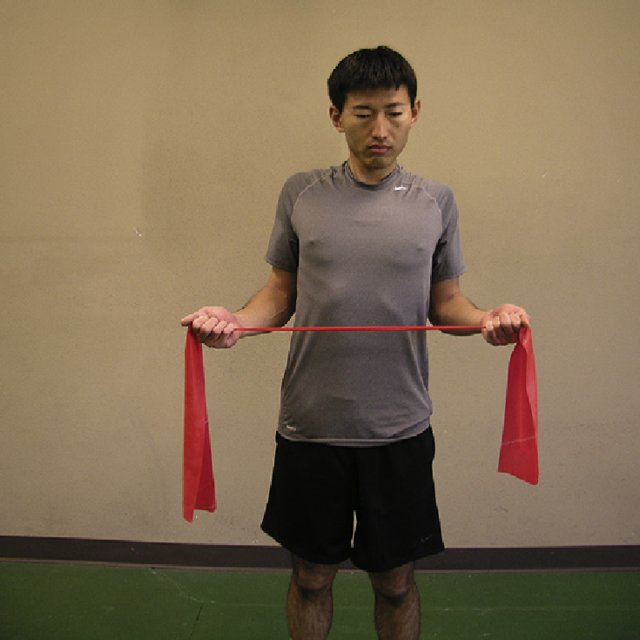
Scapular retraction
- To do a scapular retraction put the band around a steady object, such as a bedpost, at about waist level.
- With your elbows at your sides and bent to ninety degrees, pull the band back to move your shoulder blades toward each other.
- Repeat 10 to 12 times.
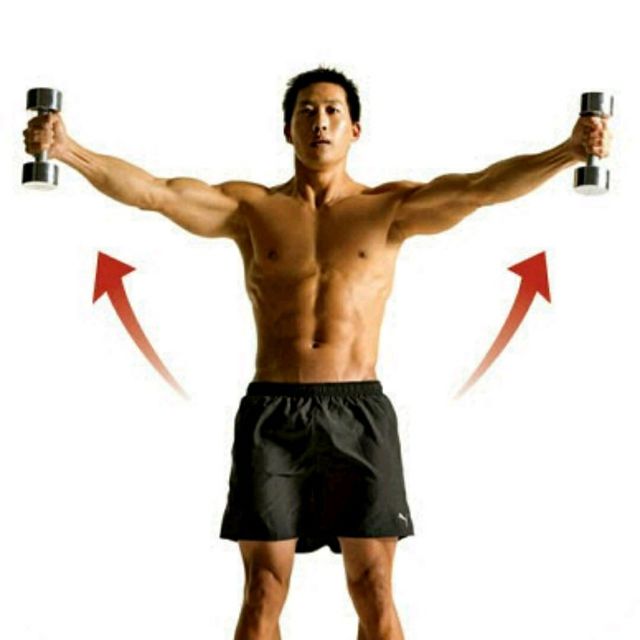
Scaption
- To do the scaption you have to Stand tall, holding a barbell in an overhand grip with your hands just outside your thighs.
- Lift your shoulders straight up, hold for 5 seconds in this elevated position, then lower them back to the beginning position.
- During exercise, you have to keep your shoulders back and your spine and elbows should be straight.
Arm Circles

- To perform arm circles you have to Stand with your hip-shoulder width apart and extend your arms parallel to the ground.
- Move your arms clockwise and anticlockwise in a small controlled motion, slowly making the circles bigger until you feel a stretch in your triceps.
- Reverse the direction of the circles after about ten seconds.
Standing dumbbell upright row
- To do this exercise you have to Stand straight by grabbing a pair of dumbbells at arm’s length in front of your waist, palms facing toward you.
- Slowly lift the dumbbell in front of your trunk, and keep it close to your body, until your elbows reach shoulder height.
- Hold for a second then reverse the movement, lowering the dumbbell back to the initial position.
Chest stretch
- To perform this exercise you have to Hold your hands behind your back. contract your shoulder blades together. For additional stretch raise your hands off the back.
Barbell front raise
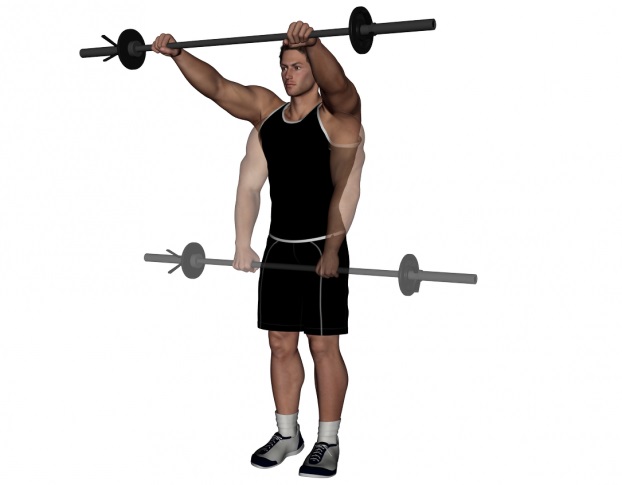
- To perform a barbell front raise get a beginning position with Stand upright holding a barbell with a shoulder-width, overhand (pronated) grip. The barbell should be resting on the front of your thighs. Drag your shoulders back and stick your chest out.
- Execution breathes out as you pull the barbell up towards your chin, making sure to stop when the barbell is level with your lower or middle chest. Do not pull the barbell any higher.
- Hold for 2 seconds. Breathe in as you lower the barbell to the initial position.
- Repeat for 15 to 25 repetitions.
Barbell shoulder press
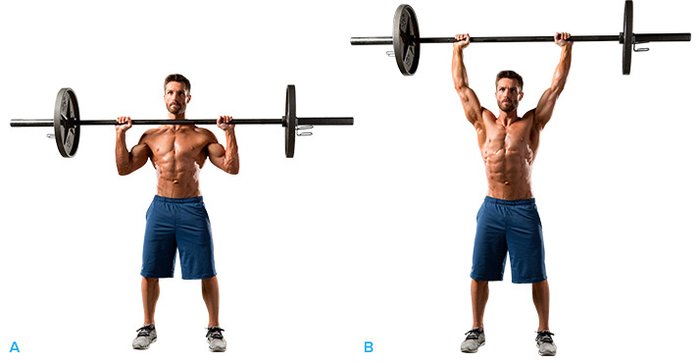
- To do a Barbell shoulder press Stand with your feet shoulder-width apart and your hips and knees fully extended, but do not lock the knees.
- Grab the barbell in a front-rack position with your elbows pointing forward and hands shoulder-width apart. This is your starting position.
- Engage your core, contract your shoulder blades together, and press the barbell overhead as you breathe out.
- Continue to press until your arms are fully flexed. This movement should feel like you are pressing your head through the “window” made by your arms.
- Squeeze your back muscles and, with control, return the barbell to the front-rack position while breathing in.
- Do 12 to 18 repetitions for 2 to 3 sets.
Upright row
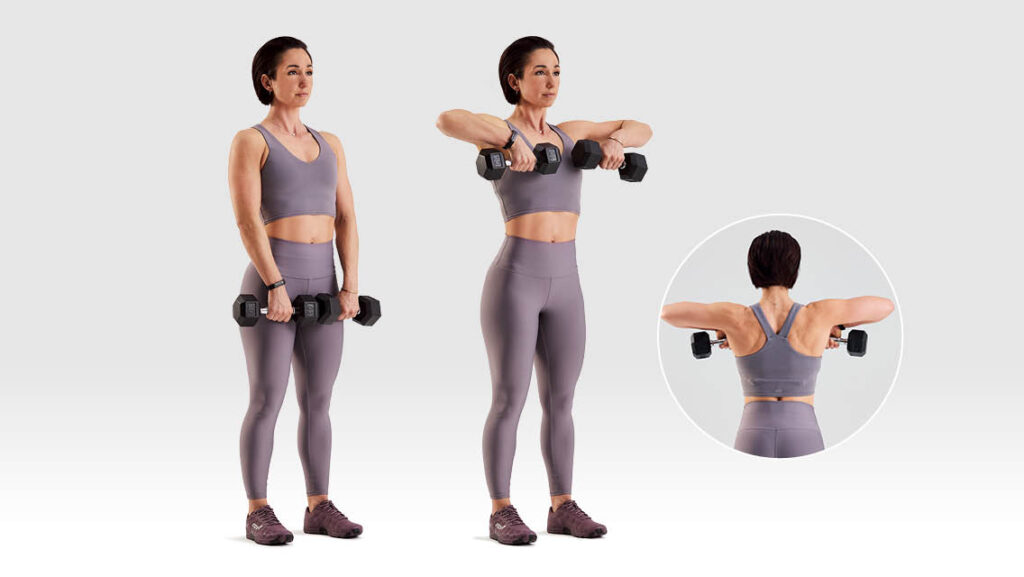
- To do an upright row you have to Stand with your hip-shoulder width apart. Clasp the dumbbells and allow them to swing in front of you at the length of your arms.
- Your palms should be facing your body and your hands in line with the thighs.
- Inhale and contract the abdominals. your torso could be straight, chest up, and your gaze forward.
- Elevate the dumbbells up (toward the chin) as you breathe out. Lead with the elbows and the dumbbells should be close to the body.
- Hold for a 10 second at the top of the movement.
- Lower the dumbbells as you breathe in, returning them to the initial position.
Front cable raise

- To perform the front cable raise Choose a weight on the low pulley machine and hold the single-hand cable attachment with your right hand.
- move away from the pulley and your arm straight down so that the hand cable attachment is in front of your thigh. keep the palm facing down. This is the initial position.
- Lift your right arm to the front. flexed your elbow slightly and keep the palm of your hand facing down. Continue lifting until your arm is positioned slightly above the level where it would be parallel to the ground. Breathe out as you do so and hold the position for 2 seconds when you reach the top.
- As you breathe in, lower your arm slowly to the initial position.
- Repeat for the number of repetitions in your set and then switch to the left arm.
High pull
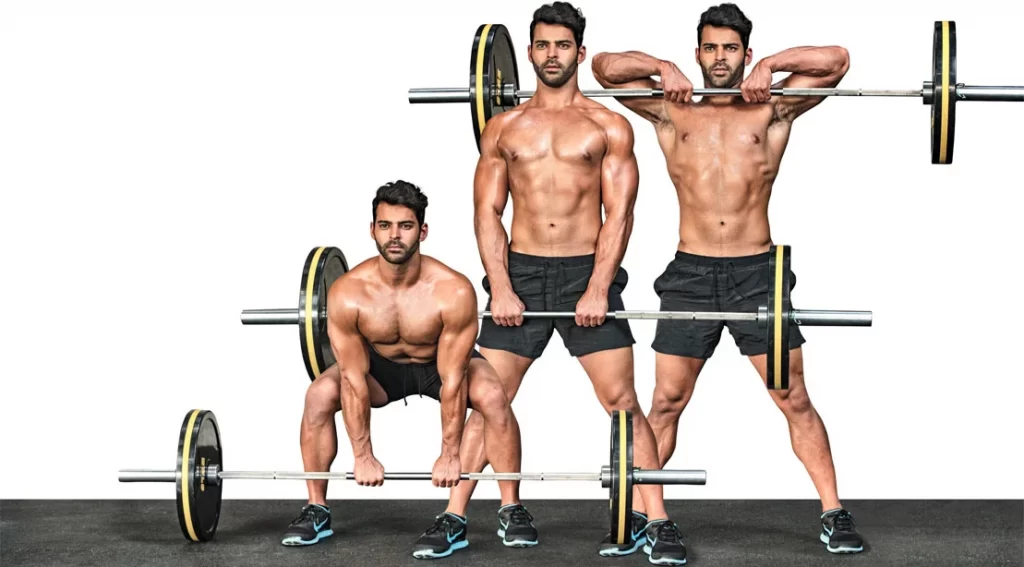
- To perform high pull exercise you can Stand with your feet hip-distance apart.
- Use an overhand grip to grab a dumbbell in both hands. Hinge at your hips to flex forward slightly. Position the dumbbell just below your knees. extended your hips and knees as you explosively raise the dumbbells as high as you can.
- simultaneously raise your heels to come onto your toes.
- Slowly lower the weight back to the initial position.
- Do 2 to 4 sets of 5 to 10 repetitions.
Behind the neck press
- To perform this exercise you have to Sit with the barbell across your trapezius.
- Place your feet on the ground with your knees flexed at 90 degrees. hold the barbell, hands wider than shoulder-width, and palms facing forward. contract your core and contract your shoulder blades together, your elbows under the barbell. Breathe out and press the barbell straight up, lining it up with your head. Hold for a second.
- Breathe out and slowly return to the initial position.
- Start with one set of 12 to 14 repetitions. then gradually increase the repetition.
Shoulder rolls
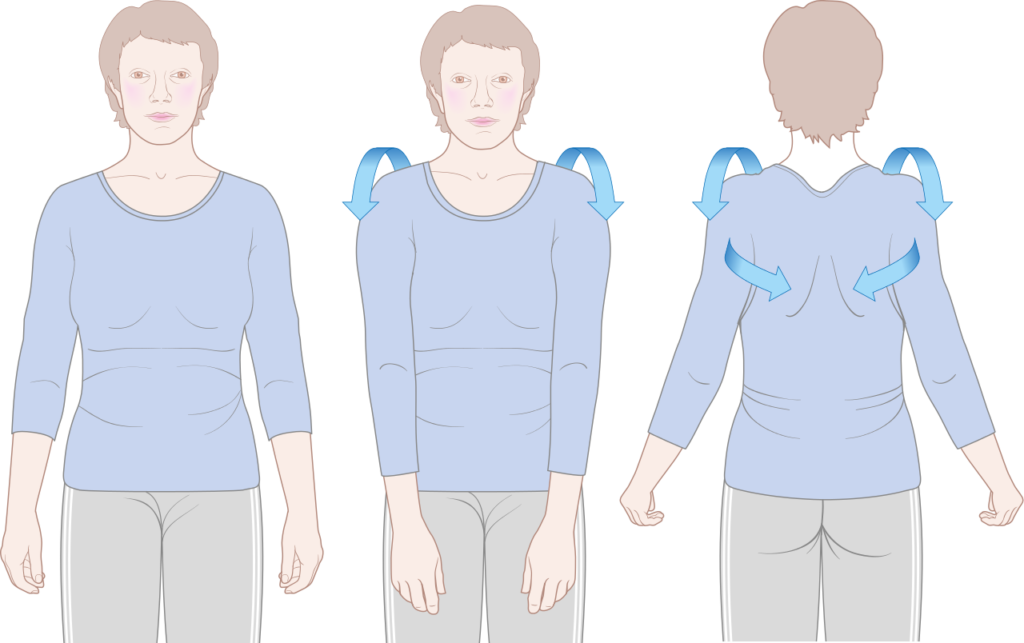
- Begin this exercise by standing or sitting tall with a proud chest, neutral spine, and engaged core. Pull your shoulders back and down. Keep your gaze forward.
- To start the shoulder roll, shrug your shoulders up toward your ears as high as you can. Perform this shoulder roll with preventing hunching back, protruding neck, or allowing your shoulders to collapse forward.
- When you shrug up as much as you can, now squeeze your shoulder blades together to pull your shoulders back.
- Contract your mid-back muscle to pull your shoulders down.
- When you reach starting position, slightly round your thorax to push your shoulders forward while maintaining strong abdominals.
- Shrug up again to do the next shoulder roll.
- Complete 10 to 15 shoulder rolls, resting 30 seconds before going into a new set.do for three to five sets.
Upright barbell row
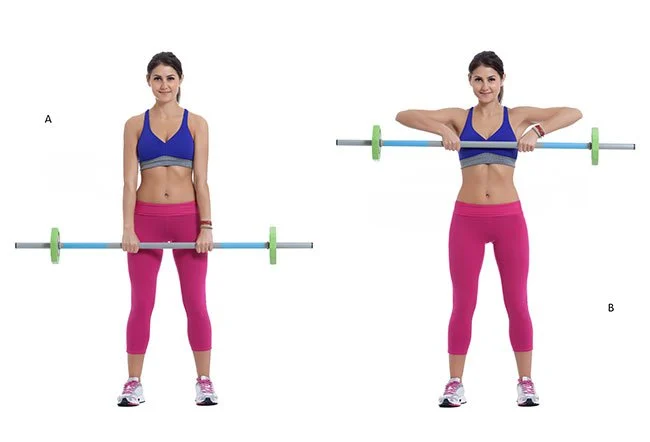
- To do an upright barbell row you have to Stand with your feet shoulder-width apart. hold the barbell and allow it to hang in front of you at the length of your arms. palms should be facing your body and your hands in line with the thighs.
- Breathe in and hold the abdominals. keep your back straight, chest up, and eyes focused forward.
- Raise the barbell (toward the chin) as you breathe out. Lead with the elbows and the barbell take close to the body.
- Hold a second at the top of the lift.
- Lower the barbell as you breathe in, returning it to the initial position.
Push press
- To do a push-press stand with feet- hip-width apart. put the barbell across your chest at shoulder height so that it rests at your collarbone. hold the barbell slightly wider than shoulder distance apart with palms facing forward. Elbows are relaxed below and slightly in front of the barbell. Legs should be extended but not locked. Knees and ankles should be aligned directly under the hips.
- keep the barbell at your chest and keep your trunk strong, flexing the knees into a slight dip. Then push through the feet and start to extend the legs. This movement is performed quickly to gain momentum.
- Once you reach full hip extension, press the barbell up. You will have to move the head slightly back to make room for the barbell to pass.
- Straighten the arms fully overhead, and keep the trunk properly aligned. Once the barbell has moved up past your head, move it back through its original position and slightly forward.
- Return the barbell to the initial position to start another repetition.
Band pull apart
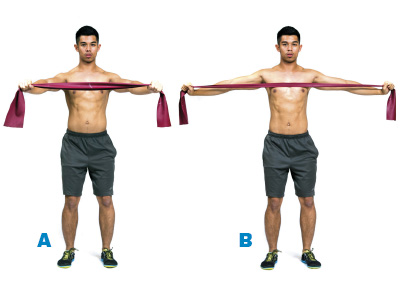
- To do a band pull-apart you have to Stand up straight and hold an exercise band out in front of you at around chest height.
- Your hands should be shoulder-width apart. Then you have to pull the band apart and contract your shoulder blades together.
- Then return to the initial position. Try to get through thirty a day.
- You can change the resistance of your band if it is too easy or hard.
Shoulder shrug

- To perform this exercise you have to Stand straight with feet flat on the ground. your arms are by your sides, turn your palms to face each other.
- If you are doing this exercise with weights, bend down and hold them now. flexed your knees slightly so that they line up with (not past) your toes. your chin should be up, facing straight ahead, and your neck should be straight.
- While you breathe in, bring your shoulders as high up toward your ears as you can.
- Do this movement gently so that you feel the resistance in your muscles.
- Lower your shoulders back down and exhale before repeating the movement.
- Do this for 3 sets of 15 repetitions to start. You can increase the number of repetitions as you build up your shoulder strength.
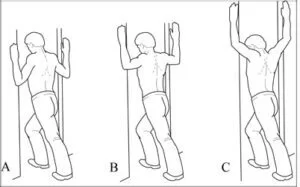
Doorway stretch
- To perform this stretch you have to Stand in an open doorway. Elevate both arms up to the side, flexed ninety-degree angles with palms forward. Rest your palms on the door frame. If this is too painful, try moving your elbows down slowly.
- Slowly take a forward step with one foot. you can feel this stretch over your shoulders and chest. Stand straight and do not move forward.
- Hold for thirty seconds. take a backward step and relax.
- Repeat three times.

Push-up
- To perform this exercise a push-up you are going to get on the ground on all fours, positioning your hands slightly wider than your shoulders. Do not lock out the elbows; keep them slightly folded. straighten your legs back so you are balanced on your hands and toes, your feet hip-width apart. Once you get this position then start a push-up.
- Engage your abdominals and tighten your core by pulling your tummy toward your spine.
- Inhale as you slowly bend your elbows and lower yourself to the floor, until your elbows are at a ninety-degree angle.
- Breathe out while contracting your chest muscles and pushing back up through your hands, returning to the initial position.
Dumbbell rear delt row
- To do this exercise you have to Lean forward with a dumbbell in both hands.
- Breathe in and make a wide rowing motion, where you let your upper arms go out towards the sides.
- With control, lower the weight back to the initial position.
Leaning dumbbell lateral raise
- Do this exercise with a dead start. With a comfortable dumbbell weight size in one hand, stand away from a steady pole, cable machine, or squat rack. With the arm hold the furthest down from the pole, your arm should be straight and win- facing you.
- Put your feet at the base of the pillar and lean outwards. The arm holding the dumbbell should swing straight down.
- Hold this position and your elbow into a slight flexion. breath in and as you breathe out while lifting the arm holding the dumbbell upwards and outwards without straining too much.
- Your arms should be at shoulder height or a bit above that level. Hold this position for 2 to 5 seconds and breath in as you drop your arms back to the initial position.
- That is 1st repetition. Switch your arms and do the same for the other side.
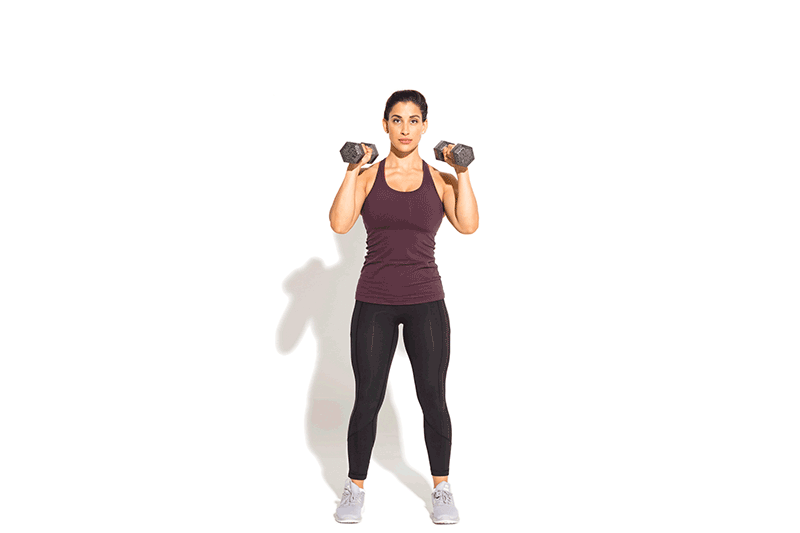
See-saw press
- Do this exercise with grab dumbbells in both hands just behind your shoulder joint, your palms should be facing forward.
- Look upward and tilt your body to the right, extending your left arm straight above you. Lower the weight and repeat the same exercise on the other side to make a see-saw movement.
Y Raise

- Do this exercise by standing with your feet shoulder-width apart and grabbing a dumbbell in both hands with your palms facing your hips.
- Flexed from trunk toward the ground. Now, Raise the weight above your head, with both palms facing each other, and form a Y with your body.
- Down the dumbbells to the initial position and repeat.
Dumbbell push press
- Do the dumbbell push press with two dumbbells of an appropriate weight. begin with one end of the dumbbells resting lightly on your shoulders, with your palms facing each other, standing with your feet hip-width apart.
- While contracting your core and your back should be straight, flex your knees slightly, just enough to get some momentum without performing a full squatting.
- As soon as the knees are slightly flexed, extend your hips and knees simultaneously by driving through your heels while pressing the dumbbells overhead.
- Slowly lower the weight back down to your shoulders and take a position for another repetition.
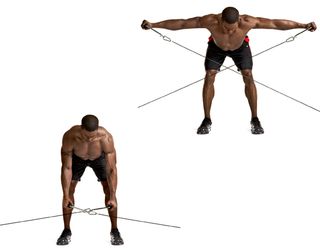
Cable reverse fly
- Do the cable reverse fly with Position two cables at chest height and attach a handle.
- Reach across your body and hold one handle with a neutral grip. Repeat this for the opposite arm.
- Position the arms straight ahead holding onto each handle and keep some flexion in the knee.
- Elbows should be slightly flexed and pull the handles laterally without squeezing the shoulder blades together excessively.
- Slowly lower the handles back to the initial position under control.
- Repeat the 10 to 15 times for 2 to 3 sets.
High plank
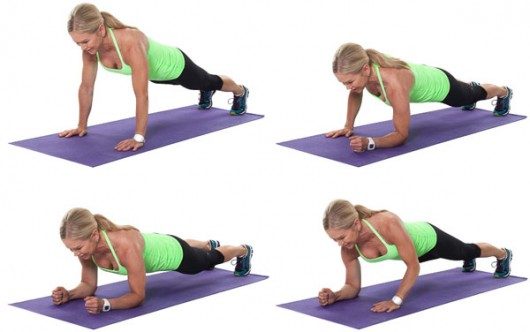
- To perform a high plank you have to come on all four limbs on the ground with hands stacked directly under shoulders and knees flexed and stacked directly under hips.
- Step single leg back at a time to come into a high plank position on palms, actively squeezing heels and buttocks together and drawing the navel to the spine.
- Hold for 20 to 30 seconds. Repeat for 3 to 4 sets. As you gain strength, increase the time to 60 seconds or more.
One-arm kettlebell push press
- To perform this exercise you have to grab a kettlebell at your shoulder height.
- Keep your trunk upright, flex your knees, and drive through your legs to press the kettlebell above your head.
- Lower it back to the initial position and do it again for 10 to 12 repetitions.
Plank
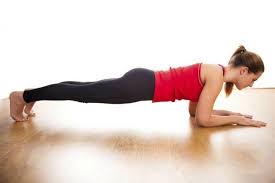
- To perform a plank you have to come on all four limbs on the ground with hands stacked directly under shoulders and knees flexed and stacked directly under hips.Your head is relaxed and your gaze at the ground.
- Contract your abdominal muscles, drawing your navel toward your spine. Keep your torso straight and rigid and your body in a straight line from your ears to your toes with no flexing and sagging. This is the neutral spine position. make sure your shoulders are down, not shrug toward your ears. keep toes over the floor.
- Hold this position for 20 seconds. Release to ground.
- Over time work up to 30, 40, or 50 seconds.
Pike pushups
- Take a plank position on the ground, with hands firmly on the ground, right under your shoulders. Press your toes firmly into the ground too. your core muscles should be tight and your back flat and contract your glutes and hamstrings.
- Your overall body should be neutral and in a straight line. raise your hip joint up and back up to your body forms an inverted V shape. arms and legs should be straight as possible. Start to flexed elbows, and then lower your entire upper body toward the ground.
- Stay there for a moment, then slowly push back up until your arms are straight and you are in the inverted V position.
- Make sure you maintain control throughout the movement.

Across the Chest Stretch
- If you do this stretching regularly, it will help flexibility in the shoulder muscles. However, you should not proceed with this exercise if you experience any pain.
- Put your left arm over the chest
- Position it in the crease of your right elbow. Alternately, make use of your right hand to support the arm. Hold the position for a minimum of sixty seconds.
- Repeat this stretch on the other side with your right arm. Repeat the set 3 times
Safety Precautions to Take While Exercising for Shoulder
- Make sure you are wearing comfortable clothes and appropriate footwear.
- Warm up before starting any exercise.
- Eat light before exercise, but do not exercise on an empty tummy.
- Do not eat just after exercising.
- While doing exercise, make sure your fluid intake and drinking water should be more.
- Take small breaks as applicable.
- Do not do any exercise if you are suffering from health issues, consult to your physician then start the exercise.
- The same muscle group should be trained two to three days a week with at least 48 hours separating the same muscle group.
FAQ
What is the importance of shoulder exercise?
Shoulder muscle strengthening exercises can improve healthy movement patterns and correct posture and muscle function. performing these exercises on a regular schedule can help to treat and prevent injuries and allow you to move with greater ease and strength in the shoulder joint.
Is it good to do a shoulder workout every day?
Yes, you can utilize your shoulder muscle often but only if you are not constantly strengthening them with heavy weights. Instead, spend a lot of time doing exercises that strengthen your mid-back muscles and rotator cuff muscles.
How many repetitions and sets are preferable for a shoulder muscle workout?
For shoulder joint muscles each head of the deltoid can be 10-12 total sets in a week. This can mostly be done by splitting up the overall training volume into 2-4 sets each, 2-4 times a week.
Are shoulder exercises push or pull?
The shoulder exercise is done with Push workouts to train the chest, shoulders, and triceps, while pull workouts train the back, biceps, and forearm muscles.
What is the importance of the shoulder?
Strong shoulder muscles are helpful for everyday tasks of lifting and carrying, and also for better posture. Even they also make you look handsome.

